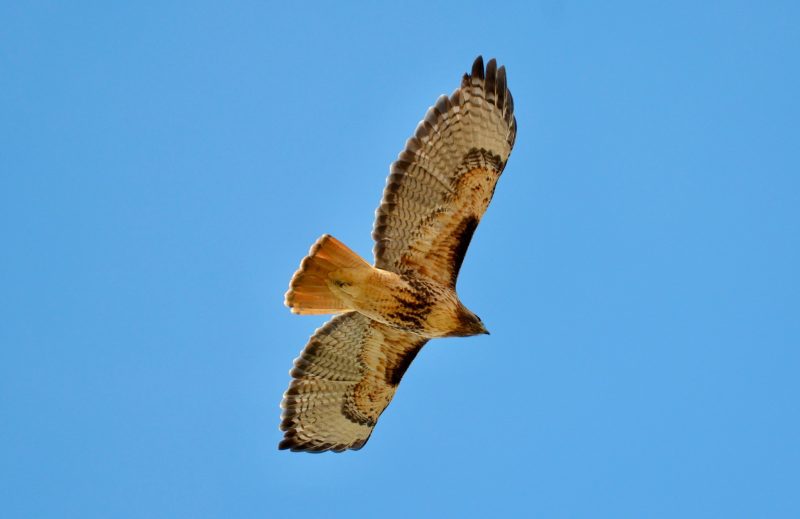The Red-tailed Hawk is one of the most iconic birds of prey in North America. Recognizable for its distinctive red tail and impressive hunting skills, this raptor has several unique characteristics that help it thrive in diverse environments. Let’s explore eight key traits that define the Red-tailed Hawk.

1. Large Size and Broad Wingspan
Striking Size and Presence
The Red-tailed Hawk is an impressive raptor, with a robust body length ranging from 45 to 65 centimeters (18 to 26 inches). Its wingspan, an impressive 110 to 145 centimeters (43 to 57 inches), combines power and elegance, enabling the bird to dominate the skies. This expansive wingspan is essential for generating the strong lift needed to remain airborne effortlessly.
Effortless Soaring on Thermal Currents
Equipped with broad, strong wings, the Red-tailed Hawk masterfully harnesses thermal updrafts—columns of rising warm air—to glide smoothly across the landscape. This soaring ability allows the hawk to conserve precious energy during long hunts and migrations, covering vast territories with minimal wing flapping while scanning for prey below.
2. Distinctive Red Tail
A Signature Mark of Identification
One of the most recognizable features of the Red-tailed Hawk is its striking, rusty red tail feathers. This vibrant coloration stands out vividly in flight, making it a reliable field mark for birdwatchers and researchers alike. The red tail not only adds to the bird’s majestic appearance but also plays a role in communication and signaling among hawks.
Tail Changes from Juvenile to Adult
Juvenile Red-tailed Hawks lack the iconic red tail; instead, they sport brown, heavily barred tails that provide excellent camouflage. As they mature over their first year, these brown tails slowly transition to the rich red hue, signaling their entry into adulthood and readiness to establish territory and breed.
3. Sharp Hooked Beak and Strong Talons
Specialized Tools for Hunting
The Red-tailed Hawk’s sharp, hooked beak is perfectly engineered for tearing through the flesh of its prey. This curved beak allows the hawk to efficiently rip meat apart, making feeding faster and easier.
Powerful Grip and Swift Kill
Complementing the beak are its formidable talons—strong, curved claws designed to grasp and immobilize prey with incredible force. These talons enable the hawk to seize animals like rodents, rabbits, and smaller birds quickly, ensuring a successful hunt and minimizing struggle. Together, the beak and talons make the Red-tailed Hawk a highly effective predator.
4. Exceptional Vision
Superior Visual Acuity
Red-tailed Hawks possess eyesight that is up to eight times sharper than that of humans. This extraordinary vision enables them to detect even small prey animals from hundreds of feet in the air, giving them a significant advantage during hunting.
Precision Hunting Advantage
Their eyes contain a high concentration of photoreceptor cells and a deep fovea — a specialized area for sharp central vision. This combination provides outstanding depth perception and focus, allowing hawks to accurately judge distances and swiftly target moving prey with pinpoint precision.
5. Versatile Hunting Techniques
Soaring and Scanning
Red-tailed Hawks are frequently observed soaring high above open landscapes, skillfully using thermal updrafts to conserve energy while scanning vast areas for signs of movement below. This broad aerial vantage point allows them to spot potential prey from great distances.
Perch Hunting Strategy
In addition to soaring, these hawks employ a stealthier approach by perching quietly on trees, fence posts, or utility poles. From these elevated lookout points, they patiently wait for prey to come within striking distance before launching rapid and precise attacks, showcasing their adaptability in various hunting scenarios.
8. Territorial and Nesting Behavior
Nest Building
Red-tailed Hawks construct large, sturdy nests made of sticks, typically located high in tall trees, on cliffs, or occasionally on man-made structures like utility poles or building ledges. These nests are often reused year after year, with the hawks adding new materials each breeding season to expand and reinforce them.
Territory Defense
During the breeding season, these hawks become highly territorial and exhibit aggressive behaviors to defend their nesting area. They actively ward off potential intruders—including other hawks and predators—to safeguard their eggs and chicks, ensuring a higher chance of reproductive success.
Conclusion
The Red-tailed Hawk’s size, distinctive red tail, sharp vision, and versatile hunting methods make it a formidable predator. Its adaptability to different habitats and strong territorial instincts ensure its survival across North America. Understanding these eight characteristics provides valuable insight into why the Red-tailed Hawk is such a successful and admired bird of prey.






